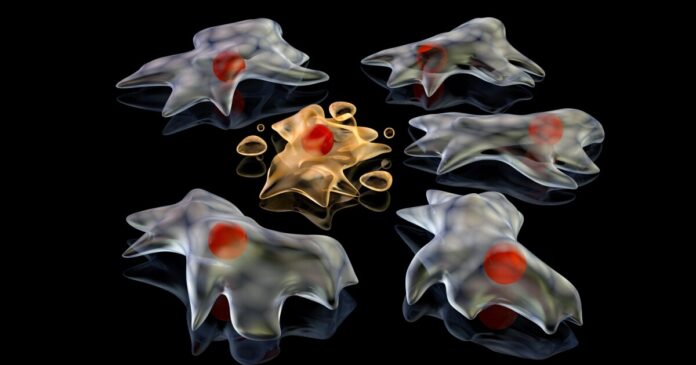Even in death, cells leave a trace. Scientists have discovered a microscopic “Footprint of Death” that not only helps the immune system clean up but can also give viruses a new way to spread infection.
When cells die by apoptosis, a natural, programmed form of cell death, they send signals to nearby immune cells (phagocytes) to come and clean up the remains. Scientists already know about some of these, including “find-me” and “eat-me” signals, and the tiny bubble-like packages released by dying cells called apoptotic extracellular vesicles (ApoEVs).
However, a new study led by La Trobe University has identified a physical trace left by dying cells that attaches to surfaces and could help direct phagocytes to the exact spot of death. The researchers have named the trace the “Footprint of Death” or, slightly less ominously, FOOD.
“Understanding this basic biological process could open new avenues of research to develop new treatments that harness these steps and help the immune system better fight disease,” said the study’s co-corresponding author, Professor Ivan Poon, PhD, head of the laboratory at the La Trobe Institute for Molecular Science (LIMS). “Billions of cells are programmed to die each day as a part of normal turnover and disease progression, and until now, it was believed that the cell fragmentation process during cell death was random and fairly simple.”
The researchers used microscopy, live-cell imaging, protein analysis (proteomics), and viral infection models to study how FOOD forms and behaves. Some of the approaches included inducing human and mouse cells to undergo apoptosis, using advanced microscopy to capture how cells retract during death and leave “footprints” behind, and the proteins found in FOOD structures, so as to better understand their makeup and role.
They found that when adherent cells – that is, those attached to surfaces – die, they retract their cell bodies and leave behind a thin, membrane-encased footprint that remains attached to the surface. These footprints are rich in F-actin, a structural protein, and other adhesion proteins. They are anchored to the underlying surface, unlike most other extracellular vesicles that float away. FOOD appears in almost all cell types tested and under various death triggers.
After a cell leaves its footprint, the leftover membrane gradually rounds into roughly 2-µm-wide vesicles called FOOD-derived extracellular vesicles (F-ApoEVs). These vesicles trigger a classic “eat-me” signal that tells immune cells to engulf them. The process depends on the activation of ROCK1, a protein that regulates cell contraction. When ROCK1 is disabled, the FOOD doesn’t form properly. Proteomic analysis found 601 proteins in FOOD, including those involved in cell structure and adhesion (actin, tubulin, vinculin, and integrins). There was very little nuclear or mitochondrial material, suggesting that FOOD mainly contains membrane and cytoskeletal elements.
When immune cells (macrophages) were placed near FOOD, they recognized and engulfed the F-ApoEVs, effectively identifying the site of cell death. Macrophages exposed to FOOD became better at clearing up other dying cells afterwards, suggesting that FOOD “primes” them for clearance work. In cells infected with influenza A, FOOD and F-ApoEVs contained viral proteins and even whole virions, which are the complete, infectious viral particles that exist outside a host cell. When these infected vesicles were mixed with healthy cells, they spread the infection, showing FOOD could act as a viral reservoir. This means that the same process that helps the immune system locate dead cells can also, in some cases, be hijacked by viruses to infect new cells.
“We know that the body clears away dead cell fragments to prevent them lingering and causing inflammation and autoimmune diseases such as systemic lupus erythematosus (SLE), and we saw F-ApoEVs are readily cleared from the site of cell death,” said lead author, PhD candidate Stephanie Rutter, a senior researcher in Poon’s LIMS lab. “What we didn’t expect was how viruses can also take advantage of this process and cause infection by hiding in F-ApoEVs.”
“This study has revealed that dying cells can continue to communicate from the grave and may impact immune function,” added the study’s other corresponding author, Georgia Atkin-Smith, PhD, a senior postdoctoral researcher at the Walter and Eliza Hall Institute of Medical Research (WEHI).
The study has limitations. It was mainly conducted in vitro (in cell cultures), so it’s unclear how FOOD behaves inside living organisms. FOOD formation was seen mostly in adherent cells, so its role in free-floating (that is, non-adherent) cells, like blood cells, may differ. The long-term fate of FOOD structures in tissues, such as whether they persist or degrade, remains unknown. Finally, the findings on viral spread are specific to influenza A; other viruses may behave differently.
Nonetheless, FOOD could explain how certain viruses persist and spread in tissues even after infected cells die. Since FOOD helps macrophages find and clear dead cells, it might inspire new strategies for promoting tissue repair or controlling inflammation. Studying FOOD further could lead to therapies that modulate immune responses more precisely.
“The more we understand about cell death and what happens to cells after they die, the better we can understand disease pathologies and find new treatments,” Rutter said.
The study was published in the journal Nature Communications.
Source: La Trobe University


